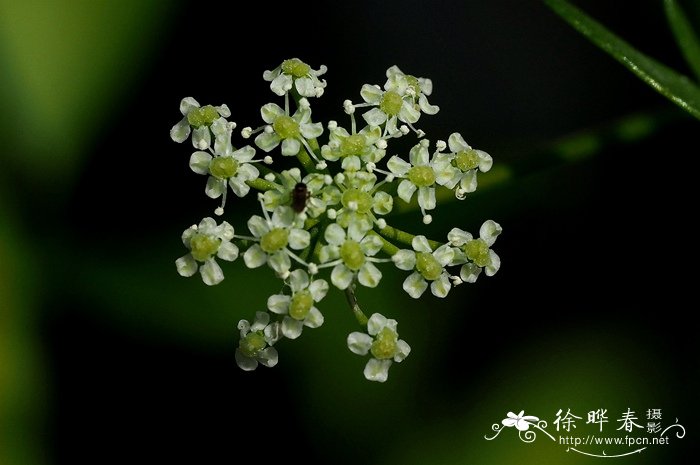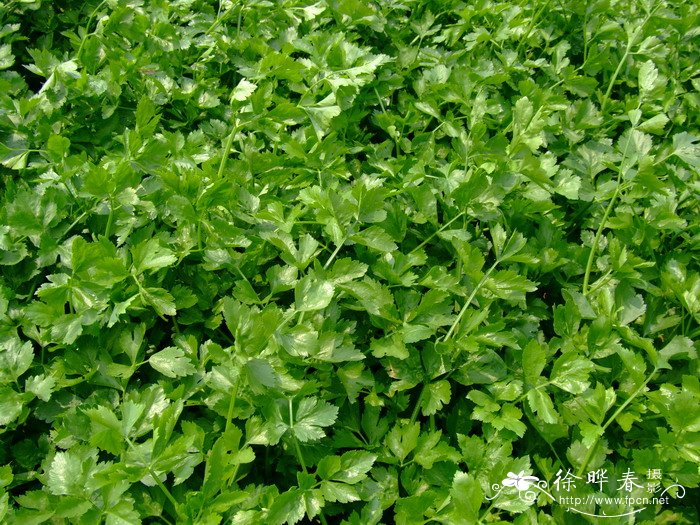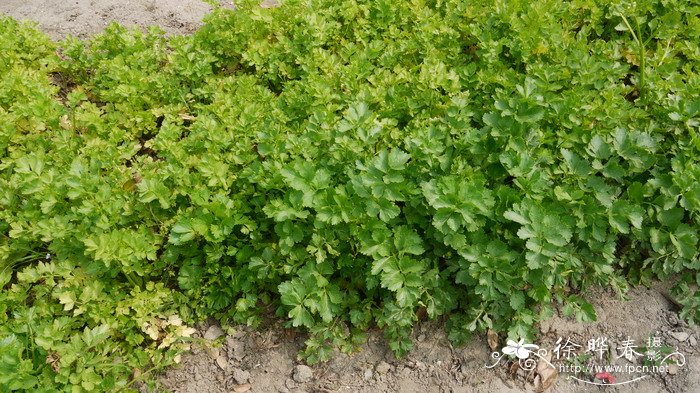旱芹Apium graveolens
中文名(Chinese Name):旱芹
学名(Scientific Name):Apium graveolens L.
英文名(English Common Name):
别名(Chinese Common Name):芹菜
异名(Synonym):Apium integrilobum Hayata Apium graveolens var. dulce (Mill.) Pers. Apium celleri Gaertn. Apium decumbens Eckl. & Zeyh. Apium dulce Mill. Apium rapaceum Mill. Apium graveolens f. lusitanicum (Mill.) J.Helm Apium graveolens subsp. butronensis (D.Gómez & G.Monts.) Aizpuru Apium graveolens var. bashmensis Hosni Apium graveolens var. butronensis D.Gómez & G.Monts. Apium graveolens var. lusitanicum (Mill.) DC. Apium graveolens var. maritimum Dumort. Apium lobatum Gilib. Apium lusitanicum Mill. Apium palustre Thore Carum graveolens (L.) Koso-Pol. Celeria graveolens (L.) Britton Helosciadium ruta DC. Helosciadium rutaceum St.-Lag. Selinum graveolens Krause Sium graveolens Vest Sison ruta Burm.f. Sison trifidum Burm. ex DC. Sium apium Roth
科属(Family & Genus):伞形科Umbelliferae芹属Apium
形态特征(Description):二年生或多年生草本,高15-150厘米,有强烈香气。根圆锥形,支根多数,褐色。茎直立,光滑,有少数分枝,并有棱角和直槽。根生叶有柄,柄长2-26厘米,基部略扩大成膜质叶鞘;叶片轮廓为长圆形至倒卵形,长7-18厘米,宽3.5-8厘米,通常3裂达中部或3全裂,裂片近菱形,边缘有圆锯齿或锯齿,叶脉两面隆起;较上部的茎生叶有短柄,叶片轮廓为阔三角形,通常分裂为3小叶,小叶倒卵形,中部以上边缘疏生钝锯齿以至缺刻。复伞形花序顶生或与叶对生,花序梗长短不一,有时缺少,通常无总苞片和小总苞片;伞辐细弱,3-16,长0.5-2.5厘米;小伞形花序有花7-29,花柄长1-1.5毫米萼齿小或不明显;花瓣白色或黄绿色,圆卵形,长约1毫米,宽0.8毫米,顶端有内折的小舌片;花丝与花瓣等长或稍长于花瓣,花药卵圆形,长约0.4毫米;花柱基扁压,花柱幼时极短,成熟时长约0.2毫米,向外反曲。分生果圆形或长椭圆形。花期4-7月。
分布(Distribution):分布于欧洲、亚洲、非洲及美洲。
用途(Use):我国南北各省区均有栽培供作蔬菜。果实可提取芳香油,作调合香精。
引自中国植物志英文版:FOC Vol. 14 Page 76
Apium graveolens Linnaeus, Sp. Pl. 1: 264. 1753.
旱芹 han qin | Apiaceae | Apium
Apium integrilobum Hayata.
Plants 15–150 cm, strongly fragrant. Basal leaves oblong to obovate, 7–18 × 3.5–8 cm, 3-lobed to 3-parted; ultimate segments subrhombic, 1.2–2.5 × 0.8–2.5 cm, crenate or serrate. Upper leaves short-petiolate; blade broad-triangular, usually 3-parted, ultimate segments obovate. Umbels 1.5–4 cm across, usually leaf-opposed; peduncles usually short, 4–15 mm, stout, rarely obsolete; rays 3–8(–16), 0.5–2.5 cm, slender; umbellules 7–25-flowered, 6–9 mm across; pedicels 1–1.5 mm. Fruit 1.3–1.5 × 1–2 mm. Fl. and fr. Apr–Jul.
Widely cultivated and adventive throughout China [?native to Asia and Europe; cultivated and adventive worldwide].
This cosmopolitan species is cultivated as a vegetable (celery and celeriac) and is adventive in temperate regions worldwide. It has been cultivated since ancient times and features in the herbal medicinal traditions of many civilizations. All parts of the plant are used in traditional Chinese medicine as the dietary herb “qin” (also known as “han qin” and “qin cai”). There are several cultivated varieties; the culivated Chinese celery is thought to be close or identical to var. secalinum Alefeld.




(责任编辑:徐晔春)
学名(Scientific Name):Apium graveolens L.
英文名(English Common Name):
别名(Chinese Common Name):芹菜
异名(Synonym):Apium integrilobum Hayata Apium graveolens var. dulce (Mill.) Pers. Apium celleri Gaertn. Apium decumbens Eckl. & Zeyh. Apium dulce Mill. Apium rapaceum Mill. Apium graveolens f. lusitanicum (Mill.) J.Helm Apium graveolens subsp. butronensis (D.Gómez & G.Monts.) Aizpuru Apium graveolens var. bashmensis Hosni Apium graveolens var. butronensis D.Gómez & G.Monts. Apium graveolens var. lusitanicum (Mill.) DC. Apium graveolens var. maritimum Dumort. Apium lobatum Gilib. Apium lusitanicum Mill. Apium palustre Thore Carum graveolens (L.) Koso-Pol. Celeria graveolens (L.) Britton Helosciadium ruta DC. Helosciadium rutaceum St.-Lag. Selinum graveolens Krause Sium graveolens Vest Sison ruta Burm.f. Sison trifidum Burm. ex DC. Sium apium Roth
科属(Family & Genus):伞形科Umbelliferae芹属Apium
形态特征(Description):二年生或多年生草本,高15-150厘米,有强烈香气。根圆锥形,支根多数,褐色。茎直立,光滑,有少数分枝,并有棱角和直槽。根生叶有柄,柄长2-26厘米,基部略扩大成膜质叶鞘;叶片轮廓为长圆形至倒卵形,长7-18厘米,宽3.5-8厘米,通常3裂达中部或3全裂,裂片近菱形,边缘有圆锯齿或锯齿,叶脉两面隆起;较上部的茎生叶有短柄,叶片轮廓为阔三角形,通常分裂为3小叶,小叶倒卵形,中部以上边缘疏生钝锯齿以至缺刻。复伞形花序顶生或与叶对生,花序梗长短不一,有时缺少,通常无总苞片和小总苞片;伞辐细弱,3-16,长0.5-2.5厘米;小伞形花序有花7-29,花柄长1-1.5毫米萼齿小或不明显;花瓣白色或黄绿色,圆卵形,长约1毫米,宽0.8毫米,顶端有内折的小舌片;花丝与花瓣等长或稍长于花瓣,花药卵圆形,长约0.4毫米;花柱基扁压,花柱幼时极短,成熟时长约0.2毫米,向外反曲。分生果圆形或长椭圆形。花期4-7月。
分布(Distribution):分布于欧洲、亚洲、非洲及美洲。
用途(Use):我国南北各省区均有栽培供作蔬菜。果实可提取芳香油,作调合香精。
引自中国植物志英文版:FOC Vol. 14 Page 76
Apium graveolens Linnaeus, Sp. Pl. 1: 264. 1753.
旱芹 han qin | Apiaceae | Apium
Apium integrilobum Hayata.
Plants 15–150 cm, strongly fragrant. Basal leaves oblong to obovate, 7–18 × 3.5–8 cm, 3-lobed to 3-parted; ultimate segments subrhombic, 1.2–2.5 × 0.8–2.5 cm, crenate or serrate. Upper leaves short-petiolate; blade broad-triangular, usually 3-parted, ultimate segments obovate. Umbels 1.5–4 cm across, usually leaf-opposed; peduncles usually short, 4–15 mm, stout, rarely obsolete; rays 3–8(–16), 0.5–2.5 cm, slender; umbellules 7–25-flowered, 6–9 mm across; pedicels 1–1.5 mm. Fruit 1.3–1.5 × 1–2 mm. Fl. and fr. Apr–Jul.
Widely cultivated and adventive throughout China [?native to Asia and Europe; cultivated and adventive worldwide].
This cosmopolitan species is cultivated as a vegetable (celery and celeriac) and is adventive in temperate regions worldwide. It has been cultivated since ancient times and features in the herbal medicinal traditions of many civilizations. All parts of the plant are used in traditional Chinese medicine as the dietary herb “qin” (also known as “han qin” and “qin cai”). There are several cultivated varieties; the culivated Chinese celery is thought to be close or identical to var. secalinum Alefeld.
(责任编辑:徐晔春)
踩一下[4]

顶一下[1]